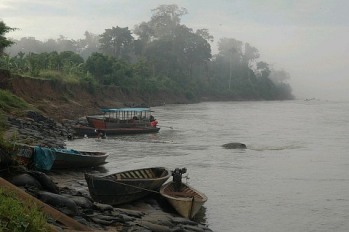Environmentalists and indigenous groups have come together to condemn a 15 million US dollar plan for six hydroelectric dams in the Peruvian Amazon, signed last week by Brazilian President Luiz Inácio Lula da Silva and Peruvian President, Alan Garcia. While the six dams would produce over 6,000 megawatts, mostly for Brazil, critics say the dams will flood tens of thousands of hectares of rainforest, devastate the lifestyles of a number of indigenous groups, and only serve big Brazilian corporations.
“This accord will not guarantee clean and renewable energy for Peru. On the contrary, it will impose a series of negative environmental and social impacts such as displacement of indigenous people and deforestation in at least 5 departments of Peru, putting at grave risk the future of the Peruvian Amazon,” Mariano Castro, former Executive Secretary of the Peruvian National Environment Council (CONAM) and lawyer with the Peruvian Society of Environmental Rights (SPDA), said in a press release by the environmental organization, International Rivers.
According to International Rivers, the construction of Paquitzapango Dam on the Ene River, a headwater of the Amazon River, would impact 17,000 of the Ashaninka tribe, the largest indigenous group in the Peruvian Amazon. As well, the dams would threaten two protected areas: the Ashaninka Communal Reserve and the Otishi National Park.
 The Madre de Dios River in Peru. Photo by: Marcin Nowak. |
The Ashaninka community has already lost land due to government allowance of oil activities and logging in historical Ashaninka areas. The Ashaninka say that they have not been consulted related to the Paquitzapango Dam.
“The Paquitzapango dam is being planned without a dialogue between the Peruvian government and the people that would be impacted by those projects,” said Ruth Buendia Mestoquiari, an Ashaninka indigenous leader. “The Ene River is the soul of our lands, the river that feeds our forests, animals, plants, crops and, especially, our children.”
Another dam in the agreement, the Inambari Dam on the Madre de Dios River, would leave 46,000 hectares of rainforest under water, while 15,000 people would lose their agricultural livelihood.
“This deal will only benefit Brazil, and we are not going to let this happen,” pledged Alfredo Novoa Pena, an engineer and founder of the Peruvian environmental organization Pro-Naturaleza.
Brazilian professor of electrical enginrering at the University of Sao Paulo, Célio Bermann, told International Rivers that the agreement is not meant to meet the energy needs of the Brazilian people but of big national and international extractive corporations.
“The energy that will be produced will serve the interests of international and Brazilian mining and metallurgy companies that are ever-expanding in the Amazon. The power will not go to meet the needs of everyday Peruvians or Brazilians.”
Over the last few years, Peru has increasingly opened its Amazon to large-scale development, driving conflict between indigenous people in Peru and the Alan Garcia administration, including a standoff last year in Bagua that left 23 police officers and 10 indigenous protestors dead, though indigenous groups claim the number of killed was far higher than authorities have admitted.
Currently, 41 percent of the Peruvian Amazon is covered by active gas and oil concessions, while 75 percent of the nation’s Amazon rainforest is open to further exploration.
The Brazilian government has stated that increasing electricity though hydropower is necessary in meeting its energy needs through ‘green’ energy sources. However, studies have shown that dams, especially those in the tropics, emit significant amounts of methane—a greenhouse gas which is approximately 20 times more potent than carbon—due to rotting vegetation in reservoirs. Destruction of forest as well releases carbon. In same cases in the tropics, dams have been found to produce significantly more greenhouse gases than fossil fuels.
The six dams in question were designed by a number of Brazilian companies: Eletrobrás (energy company), Odebrecht and Camargo Corrêa (construction companies), and BNDES (the Brazilian national bank).
Related articles
‘Prepare for war’: tensions rising over Brazil’s controversial Belo Monte dam
(05/25/2010) Tensions are flaring after Brazil’s approval of the Belo Monte dam project last month to divert the flow of the Xingu River. The dam, which will be the world’s third larges, will flood 500 square miles of rainforest, lead to the removal of at least 12,000 people in the region, and upturn the lives of 45,000 indigenous people who depend on the Xingu. After fighting the construction of the dam for nearly thirty years, indigenous groups are beginning to talk of a last stand.
Off and on again: Belo Monte dam goes forward, protests planned
(04/20/2010) An auction to build the Belo Monte dam, a massive hydroelectric project in Brazil, is going ahead despite two court-ordered suspensions, both of which have been overturned. The dam, which would be the world’s third-largest, has been criticized by indigenous groups, environmental organizations, and most recently filmmaker James Cameron who created the wildly popular Avatar.
Will Brazil’s blackout drive a new push for more rainforest dams?
(11/12/2009) The power outage that affected nearly a third of Brazil’s population Tuesday could be used by development interests to justify a renewed push for hydroelectric dams in the Amazon rainforest.